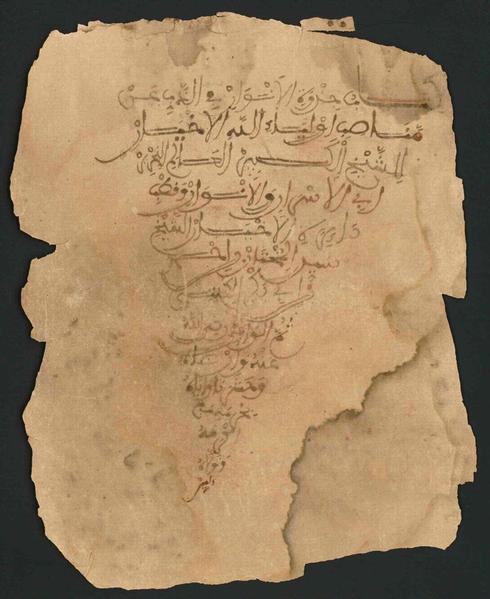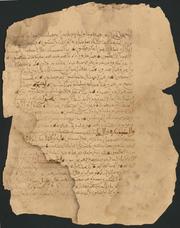File:The Rewards of the Enlightened for their Defense of the Status of God’s Chosen Saints WDL9663.pdf

Original file (879 × 1,075 pixels, file size: 20.55 MB, MIME type: application/pdf, 108 pages)
Captions
Captions
Summary edit
| Author |
Русский: аль-Мухтар ибн Ахмад ибн Аби Бакр аль-Кунти аль-Кабир, Саид
Français : al-Mukhtār ibn Aḥmad ibn Abī Bakr al-Kuntī al-Kabīr, Sayyid
English: al-Mukhtār ibn Aḥmad ibn Abī Bakr al-Kuntī al-Kabīr, Sayyid
中文:赛义德·穆赫塔尔·伊本·艾哈迈德·伊本·阿比·巴克尔·昆提·卡比尔
Português: al-Mukhtār ibn Aḥmad ibn Abī Bakr al-Kuntī al-Kabīr, Sayyid
العربية: المختار بن أحمد بن أبي بكر الكنتي الكبير, سيد
Español: al-Mukhtār ibn Aḥmad ibn Abī Bakr al-Kuntī al-Kabīr, Sayyid |
| Title |
Русский: Награды просветленным за их защиту избранных Богом святых
Français : Les récompenses des illuminés pour leur défense du statut des saints élus de Dieu
English: The Rewards of the Enlightened for their Defense of the Status of God’s Chosen Saints
中文:保护真主所选圣徒之地位的有识之士所获得的回报
Português: As recompensas dos iluminados por suas defesas do status dos santos escolhidos por Deus
العربية: جذوة الأنوار فى الذب عن أولياء الله الأخيار
Español: Las recompensas de los iluminados por su defensa de la condición de los santos elegidos por Dios |
| Description |
Русский: Тимбукту, (современный город Томбукту в Мали), основанный около 1100 года как коммерческий центр для ведения торговли в регионе Сахары, одновременно являлся важным центром исламского образования с XIV века и далее. В библиотеках Тимбукту хранилось множество ценных рукописей, выполненных в различных стилях арабского письма, которые записывались и переписывались писцами и учеными Тимбукту. Эти труды являются самым известным и наиболее ценным вкладом города в исламскую и мировую цивилизацию. Этот текст объясняет основные принципы суфизма, указывая различные стадии познания, которые проходят суфийские мистики в процессе увеличения знаний о Боге через строгое соблюдение праведной дисциплины. Далее аль-Мухтар ибн Ахмад ибн Аби Бакр аль-Кунти аль-Кабир, умерший в 1811 году, рассматривает отношения между верой, суфийским учением и знаниями о Боге.
Арабская каллиграфия; Арабские рукописи; Ислам – Доктрины; Исламские рукописи; Суфизм; Рукописи Тимбукту Français : Timbuktu (aujourd'hui Tombouctou, au Mali) fut fondée aux environs de 1100, pour servir de carrefour aux échanges commerciaux à travers le désert du Sahara. Ce fut également un très grand siège de l'enseignement islamique à partir du XIVe siècle. Les bibliothèques de Tombouctou contiennent de nombreux manuscrits importants, dans différents styles d'écritures arabes, écrits et copiés par des scribes et des érudits locaux. Ces œuvres représentent la contribution la plus célèbre et durable de la ville à la civilisation islamique et mondiale. Ce texte explique les principes fondamentaux du soufisme, décrivant les différentes étapes de la connaissance que les mystiques soufis traversent, au fur et à mesure que leur connaissance de Dieu s'accroît, par le strict respect de la discipline dévotionnelle. Al-Mukhtār ibn Ahmad ibn Abī Bakr al-Kunti al-Kabīr, mort en 1811, évoque ensuite le rapport qui existe entre la croyance, la doctrine soufie et la connaissance de Dieu.
Calligraphie arabe; Manuscrits arabes; Islam -- Doctrines; Manuscrits islamiques; Soufisme; Manuscrits de Tombouctou English: Timbuktu (present-day Tombouctou in Mali), founded around 1100 as a commercial center for trade across the Sahara Desert, was also an important seat of Islamic learning from the 14th century onward. The libraries there contain many important manuscripts, in different styles of Arabic scripts, which were written and copied by Timbuktu’s scribes and scholars. These works constitute the city’s most famous and long-lasting contribution to Islamic and world civilization. This text explains the basic principles of Sufism, pointing out the various stages of knowledge that Sufi mystics pass through as their knowledge of God increases through their strict application of devotional discipline. Al-Mukhtār ibn Aḥmad ibn Abī Bakr al-Kuntī al-Kabīr, who died in 1811, further discusses the relationship between belief, Sufi doctrine, and knowledge of God.
Arabic calligraphy; Arabic manuscripts; Islam -- Doctrines; Islamic manuscripts; Sufism; Timbuktu manuscripts 中文:廷巴克图(现今马里的通布图城)约建于 1100 年,是跨撒哈拉沙漠的商贸中心,14 世纪后在伊斯兰文化学习方面也占据着一席之地。廷巴克图的图书馆中藏有很多重要的手稿,这些手稿具有不同的阿拉伯文风格,均为廷巴克图的抄写员和学者书写和誊抄。这些作品见证了这座城市对伊斯兰和世界文明所做出的卓越而又意义深远的贡献。此文本介绍了苏菲主义的基本理念,指出了苏菲派神秘主义者在严格遵守灵修戒律、提高对真主认识的过程中,会历经的各种知识阶段。穆赫塔尔·伊本·艾哈迈德·伊本·阿比·巴克尔·昆提·卡比尔(Al-Mukhtār ibn Aḥmad ibn Abī Bakr al-Kuntī al-Kabīr,卒于 1811 年)进一步讨论了信仰、苏菲教义与对真主认识三者之间的关系。
阿拉伯文书法; 阿拉伯语手稿; 伊斯兰教 -- 教条; 伊斯兰手稿; 苏菲主义; 廷巴克图手抄本 Português: Timbuktu (atual Tombouctou em Mali), fundada em torno de 1100 como centro comercial de negócios no deserto do Saara, foi também uma importante sede de aprendizagem islâmica, do século XIV em diante. As bibliotecas do lugar contêm muitos manuscritos importantes, em diferentes estilos de escrita árabe, que foram escritos e copiados por escribas e acadêmicos de Timbuktu . Estas obras constituem a mais famosa e duradoura contribuição da cidade ao mundo islâmico e à civilização mundial. Este texto explica os princípios básicos do Sufismo, indicando as várias etapas de conhecimento que os místicos sufi passam conforme ganham conhecimento sobre Deus através de sua rigorosa aplicação da disciplina de devoção. Al-Mukhtār ibn Aḥmad ibn Abī Bakr al-Kuntī al-Kabīr, que faleceu em 1811, discute também a relação entre crença, doutrina sufi e o conhecimento sobre Deus.
Caligrafia árabe; Manuscritos árabes; Islã -- Doutrinas; Manuscritos islâmicos; Sufismo; Manuscritos Timbuktu العربية: تم تأسيس تِمبكتو (والمعروفة حالياً بتمبكتو في مالي) حوالي عام 1100 لتكون مركزاً تجارياً عبر الصحراء الكبرى، كما كانت مركزاً هاماً للتعليم الإسلامي بدايةً من القرن الرابع عشر. تحتوي مكتباتها على الكثير من المخطوطات الهامة المكتوبة بالأساليب العربية المختلفة والتي كتبها ونسخها نُساخ تمبكتو وعلماؤها. وتمثل هذه الأعمال أشهر إسهام للبلدة في الحضارة الإسلامية والعالمية وأدومها. يشرح النص المبادئ الأساسية للصوفية ويوضح المراحل المتعددة للمعرفة التي مر بها الصوفيون بزيادة معرفتهم بالله وذلك من خلال تطبيقهم الصارم لقواعد السلوك التعبدية. كذلك يناقش المختار بن أحمد بن أبي بكر الكنتي الكبير، الذي توفي في 1811، العلاقة بين الإيمان والمذهب الصوفي ومعرفة الله.
الخط العربي; المخطوطات العربية; الإسلام -- المذاهب; المخطوطات الإسلامية; التصوف; مخطوطات تمبكتو Español: Timbuctú (hoy Tombuctú, en Malí), fundada cerca del año 1100 como centro comercial para todo el desierto del Sahara, también fue un importante centro de enseñanza islámica a partir del siglo XIV. Sus bibliotecas contienen muchos manuscritos importantes en diferentes estilos de escritura árabe que fueron escritos y copiados por los escribas y eruditos de Timbuctú. Estas obras constituyen la contribución más famosa y duradera de la ciudad a la civilización islámica y mundial. Este texto explica los principios básicos del sufismo, y señala las distintas etapas del conocimiento por las que pasan los místicos sufíes a medida que aumenta su conocimiento de Dios, mediante su estricta aplicación de la disciplina devota. Además, Sayyid al-Mukhtār ibn Aḥmad ibn Abī Bakr al-Kuntī al-Kabīr, quien falleció en 1811, examina la relación entre la fe, la doctrina sufí y el conocimiento de Dios.
Caligrafía árabe; Manuscritos en árabe; Islam - Doctrinas; Manuscritos islámicos; Sufismo; Manuscritos de Tombuctú |
| Date |
1858 date QS:P571,+1858-00-00T00:00:00Z/9 |
| Medium |
Русский: Рукописи
Français : Manuscrits
English: Manuscripts
中文:手稿
Português: Manuscritos
العربية: مخطوطات
Español: Manuscritos |
| Collection |
Русский: Мемориальная библиотека Мамма Хайдара
Français : Bibliothèque commémorative Mamma Haidara
English: Mamma Haidara Commemorative Library
中文:海达拉家族纪念图书馆
Português: Biblioteca Comemorativa Mamma Haidara
العربية: مكتبة ماما حيدرة التذكارية
Español: Colección Conmemorativa Mamma Haidara |
| Place of creation |
Русский: Томбукту
Français : Tombouctou
English: Tombouctou
中文:通布图
Português: Tombouctou
العربية: تمبكتو
Español: Tombuctú |
| Notes | Original language title: جذوة الأنوار في الذب عن مناصب أولياء الله الأخيار |
| References | http://hdl.loc.gov/loc.wdl/wdl_mhcl.9663 |
| Source/Photographer |
http://dl.wdl.org/9663/service/9663.pdf
|
Licensing edit
|
This is a faithful photographic reproduction of a two-dimensional, public domain work of art. The work of art itself is in the public domain for the following reason:
The official position taken by the Wikimedia Foundation is that "faithful reproductions of two-dimensional public domain works of art are public domain".
This photographic reproduction is therefore also considered to be in the public domain in the United States. In other jurisdictions, re-use of this content may be restricted; see Reuse of PD-Art photographs for details. | |||||
File history
Click on a date/time to view the file as it appeared at that time.
| Date/Time | Thumbnail | Dimensions | User | Comment | |
|---|---|---|---|---|---|
| current | 02:20, 15 March 2014 |  | 879 × 1,075, 108 pages (20.55 MB) | Fæ (talk | contribs) | =={{int:filedesc}}== {{Artwork |artist = |author ={{ru|1=аль-Мухтар ибн Ахмад ибн Аби Бакр аль-Кунти аль-Кабир, Саид}} {{fr|1=al-Mukhtār ibn Aḥmad ibn Abī Bakr al-Kuntī al-Kabīr, Sayyid}} {{en|1=al-M... |
You cannot overwrite this file.
File usage on Commons
The following 2 pages use this file:
File usage on other wikis
The following other wikis use this file:
- Usage on en.wikipedia.org
Metadata
This file contains additional information such as Exif metadata which may have been added by the digital camera, scanner, or software program used to create or digitize it. If the file has been modified from its original state, some details such as the timestamp may not fully reflect those of the original file. The timestamp is only as accurate as the clock in the camera, and it may be completely wrong.
| Image title | This document was downloaded from the World Digital Library (http://www.wdl.org). Go to http://hdl.loc.gov/loc.wdl/wdl.9663 for more information about this item. |
|---|---|
| Keywords | This document was downloaded from the World Digital Library (http://www.wdl.org). Go to http://hdl.loc.gov/loc.wdl/wdl.9663 for more information about this item. |
| Conversion program | Mac OS X 10.6.8 Quartz PDFContext |
| Encrypted | no |
| Page size |
|
| Version of PDF format | 1.3 |
